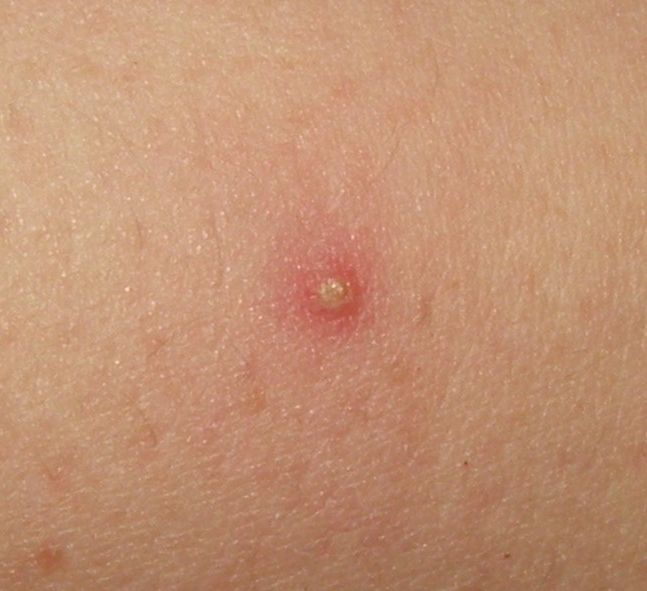
Image: "Isolated folliculitis" by Jmarchn is licensed under CC BY-SA 4.0. Link to the source.
Folliculitis
Introduction
Folliculitis is a common skin condition characterised by the inflammation of hair follicles, often presenting as small, red, pus-filled bumps around hair follicles. It can occur anywhere on the body where hair is present, but it most commonly affects the scalp, face, chest, back, buttocks, and legs. Folliculitis can be caused by infection, irritation, or other inflammatory processes.
Aetiology and Risk Factors
Folliculitis can be caused by a variety of factors, including bacterial, fungal, viral, and non-infectious causes:
- Bacterial Infections: The most common cause is Staphylococcus aureus, which infects the hair follicle, leading to inflammation. Pseudomonas aeruginosa can cause "hot tub folliculitis" after exposure to contaminated water.
- Fungal Infections: Yeast (such as Malassezia) and dermatophytes can also infect hair follicles, particularly in immunocompromised individuals.
- Viral Infections: Herpes simplex virus (HSV) can cause folliculitis, especially in the beard area, a condition known as herpetic folliculitis.
- Irritant Folliculitis: Caused by friction, tight clothing, shaving, or the use of occlusive products that block hair follicles.
- Non-Infectious Causes: Conditions like eosinophilic folliculitis, commonly seen in HIV patients, and steroid-induced folliculitis due to the use of topical or systemic corticosteroids.
- Risk Factors: Factors that increase the risk of developing folliculitis include shaving, wearing tight clothing, poor hygiene, use of hot tubs, and having a compromised immune system.
Clinical Presentation
Folliculitis typically presents with the following features:
- Papules and Pustules: Small, red bumps that may have a white tip (pustules) are often seen at the base of the hair follicle. These lesions can be itchy or tender.
- Erythema: The skin surrounding the affected hair follicles may appear red and inflamed.
- Crusting and Scabbing: In more severe cases, the pustules may rupture, leading to crusting and scabbing over the hair follicles.
- Distribution: The lesions are typically localised to areas of hair growth and are often seen in clusters.
- Chronicity: Folliculitis can be acute, lasting a few days to weeks, or chronic, with recurrent episodes over months to years.
Diagnosis
The diagnosis of folliculitis is primarily clinical, based on the appearance of the lesions and patient history. Key steps in diagnosis include:
- Clinical History: Enquire about recent shaving, use of hot tubs, exposure to irritants, and any history of similar episodes. Also, consider any underlying medical conditions that may predispose to folliculitis, such as diabetes or immunosuppression.
- Physical Examination: Examine the distribution and morphology of the lesions. Look for signs of bacterial infection, such as purulent discharge or surrounding cellulitis.
- Laboratory Tests: In cases where the diagnosis is unclear or if the infection is severe or recurrent, swabs for bacterial culture and sensitivity, or fungal cultures, may be helpful. In suspected herpetic folliculitis, viral cultures or PCR testing for HSV may be indicated.
- Biopsy: A skin biopsy is rarely needed but may be performed in atypical or chronic cases to rule out other conditions, such as acne, hidradenitis suppurativa, or keratosis pilaris.
Management and Treatment
Management of folliculitis depends on the underlying cause and severity of the condition. Treatment options include:
1. General Measures
- Good Hygiene: Encourage regular washing of the affected area with soap and water. Avoid sharing towels, razors, or other personal items to prevent the spread of infection.
- Avoiding Irritants: Advise patients to avoid shaving the affected area or using harsh soaps or detergents. If shaving is necessary, recommend the use of a clean, sharp razor and shaving in the direction of hair growth.
- Warm Compresses: Applying warm compresses to the affected area several times a day can help to soothe discomfort and promote drainage of pustules.
2. Topical Treatments
- Topical Antibiotics: Mupirocin or fusidic acid creams can be applied to the affected area in cases of mild bacterial folliculitis. These are effective against Staphylococcus aureus and should be used for 7-10 days.
- Benzoyl Peroxide: A topical antiseptic that can help reduce bacterial load and inflammation, especially in mild cases of folliculitis. It is often used as an adjunct to topical antibiotics.
- Antifungal Creams: If fungal folliculitis is suspected, topical antifungals like ketoconazole cream can be used.
- Topical Steroids: In cases of irritant or eosinophilic folliculitis, a mild topical steroid may be prescribed to reduce inflammation. However, care should be taken to avoid exacerbating the condition.
3. Systemic Treatments
- Oral Antibiotics: For more extensive or persistent bacterial folliculitis, oral antibiotics such as flucloxacillin or erythromycin may be prescribed for 7-10 days. In cases of suspected MRSA, consider doxycycline or trimethoprim.
- Oral Antifungals: If fungal folliculitis is confirmed or strongly suspected, oral antifungals such as fluconazole or terbinafine may be required, particularly in immunocompromised patients.
- Oral Antivirals: For herpetic folliculitis, oral antivirals such as aciclovir or valaciclovir should be initiated promptly.
- Oral Steroids: In severe cases of eosinophilic folliculitis or other non-infectious causes, short courses of oral steroids may be considered under specialist guidance.
When to Refer
Referral to a dermatologist may be necessary in the following situations:
- Recurrent or Chronic Folliculitis: If the patient experiences frequent recurrences or if the condition becomes chronic despite treatment.
- Severe or Resistant Cases: When folliculitis does not respond to standard therapies or is associated with significant discomfort or scarring.
- Uncertain Diagnosis: If the diagnosis is unclear or if there are atypical features that suggest an alternative diagnosis.
References
- British Association of Dermatologists (2024) Guidelines for the Management of Folliculitis. Available at: https://www.bad.org.uk (Accessed: 26 August 2024).
- National Institute for Health and Care Excellence (2024) Folliculitis: Diagnosis and Treatment. Available at: https://www.nice.org.uk/guidance/ng199 (Accessed: 26 August 2024).
- British National Formulary (2024) Topical and Systemic Treatments for Skin Infections. Available at: https://bnf.nice.org.uk/ (Accessed: 26 August 2024).
Check out our YouTube channel
Blueprint Page
Explore the comprehensive blueprint for Physician Associates, covering all essential topics and resources.
Book Your Session
Enhance your skills with personalised tutoring sessions tailored for Physician Associates.



